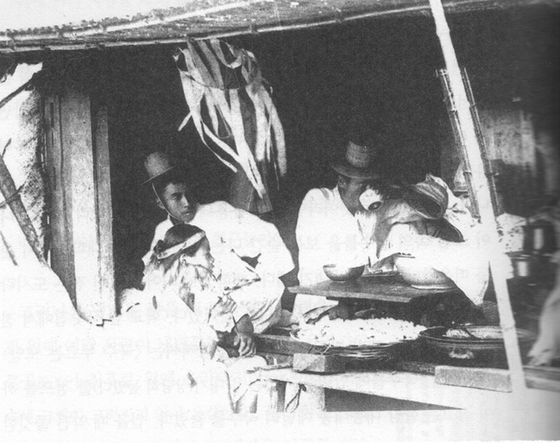In 20th century, Incheon was
always crowded with foreigners because during those days, it was the hub of
shipping trade. Also, most embassies were located at Incheon. Restaurants
targeting foreigners first appeared in early 1900 [3]. Chinese restaurants like
Gonghwachoon and Joonghwaru were first to open followed by Japanese restaurants
[1]. Eating out at those restaurants was extravagant entertainment Japanese
officials, the rich, and collaborators enjoyed. The dining out culture was new
to Chosun people because most of the time they ate at home. Officials went to
Nujeong to hang out with kisaeng and had dinner, but they did not pay for the
meal. They paid for the kisaeng’s service [4].
Image
of Myungwolgwan by Encyclopedia of Korean Culture website [2]
Bench marketing Japanese restaurants,
Soonhwan Ahn who was in charge of royal court cuisine from 1901 to 1910 opened Myungwolgwan
very first Chosun restaurant in September 17th, 1903. Myungwolgwan served royal
court cuisine. The fact that anyone with money can try “royal food” and watch
kisaeng’s court dance attracted rich Chosun commoners. Before royal court
cuisine and banquet was exclusive to king; wealth could not overcome the
bureaucracy. However, that tradition broke down in 20th century.
Government officials, businessmen, and Chosun commoners had private and public
meetings at Myungwolgwan [2, 4].
As more Japanese officials and rich Chinese
traders visited Myungwolgwan; the “royal court cuisine” catered to their
tastes. For example Myungwolgwan started serving Japanese style, sea fish
sashimi. Chosun people consume freshwater fish sashimi more while Japanese people
preferred sea fish sashimi. They served Japanese Sukiyaji in Sinseollo and
foreign fruits [1]. Though Myungwolgwan became more commercialized, people
thought everything Myungwolgwan served as “Chosun cuisine” – Myungwolgwan
served the “image of Chosun.”
Image
of Chosun people eating naengmyun
{http://idealist.egloos.com/viewer/5388848}
Besides fancy Chosun royal court cuisine
restaurants, gookbab(국밥집) restaurants were very popular
among commoners and laborers. Literal translation of gookbab is soup and rice; eating
gookbab was quick, and easy way to have a meal. Seollungtang was a classic
menu. Choo-uh tang was popular in fall while naengmyun was a hit in summer.
Different types of bibimbab were first served at gookbab restaurants [3].
Another dining out place that was
popular, especially among laborers were Daepotjib(대폿집).
Daepotjib served mak gul li and side dishes such as bin dae duk, soondae, and mae
un tang. Many laborers could drink and eat cheap after their work [3]. In 20th
century, dining out culture prospered among all social and financial classes. The dining out culture has become a "vehicle for culture and nutrition" rather than a mean for satisfying hunger [5].
FUN FACT: There is a Jjajangmyun museum in Incheon Chinatown. The museum is about the history of Gonghwachoon, one of the very first Chinese restaurants in Korean history.
Reference:
1. EBS DocuPrime: A Talk about
Korean Food. Educational Broadcasting System, 2012.
2. "Myungwolgwan." Encyclopedia of Korean Culture. Web. April. 2014
{http://encykorea.aks.ac.kr/Contents/Contents?contents_id=E0018335#}
2. "Myungwolgwan." Encyclopedia of Korean Culture. Web. April. 2014
{http://encykorea.aks.ac.kr/Contents/Contents?contents_id=E0018335#}
3. Joo, Youngha. Korean History
on Eating Table. Seoul: Humanist, 2013. Print.
4. Joo, Youngha. "The First Chosun Restaurant: Soonhwan
Ahn and Myungwolgwan." 東洋學 2011. 50 (): pp.141-162 1229-3199. Print.
5. Lee, DW. “Changes in Perspectives on Eating Out Culture after Modernization in Korea.” 中央民俗學 第十七號, 2012.3: 65-99
5. Lee, DW. “Changes in Perspectives on Eating Out Culture after Modernization in Korea.” 中央民俗學 第十七號, 2012.3: 65-99



댓글 없음:
댓글 쓰기